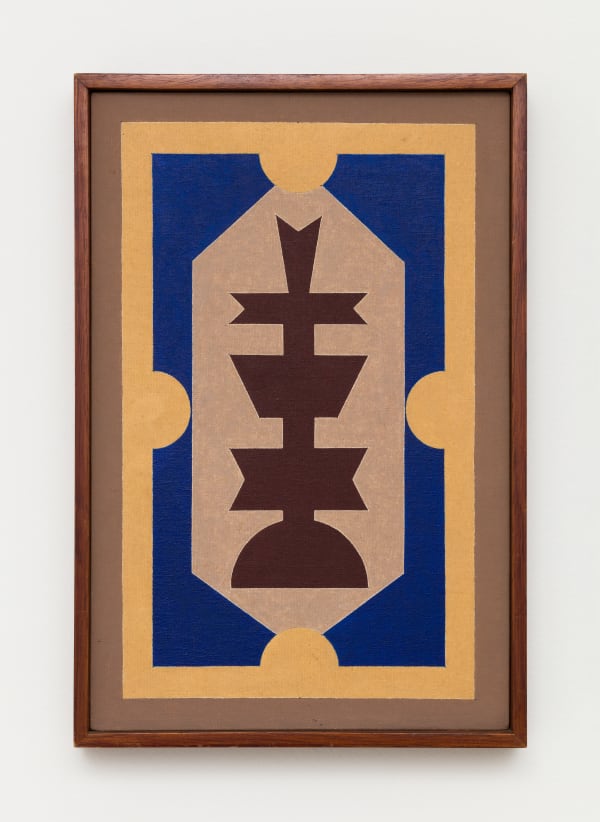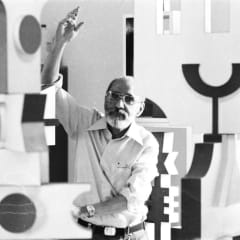Rubem Valentim
A self-taught painter, Valentim began to produce work in the late 1940s. Looking to his Afro-Brazilian heritage in search of an artistic vernacular that exemplified Brazilian cultural miscegenation, Valentim resorted to the language of geometric abstraction to construct complex compositions that redrew and reconfigured Afro-Brazilian iconography. Through this process, he transformed artistic languages from a European origin that dominated a good part of the production of art in Brazil and worldwide in the 1950s and 1960s (geometric abstraction, constructivism and concretism), by blending them with African references.
Valentim’s works are structurally organized and composed of abstract signs made from horizontal and vertical lines, circles, cubes and arrows. Unlike the purist discourse of modernism, however, the defining shapes that construct Valentim’s works are geometric reductions of Orishas, or deities, from the Afro-Brazilian religions Candomblé and Umbanda. Originally brought to the Americas by enslaved peoples from West and Central Africa, the Candomblé and Umbanda developed further from the presence of indigenous groups and the influence of the Roman Catholic Church installed in Brazil by Portuguese colonizers. This forced migration is particularly explored in Valentim’s totems, which draw from traditional African sculpture and Afro-Brazilian art. By integrating these different concepts, Valentim creates a new vernacular that represents Brazil and recognizes its origin in the African Diaspora.
In Valentim’s œuvre there is a highly subtle and precise interpenetration between the structure of a constructive base and the iconography and colorful inheritance of the magic, religious Afro-Brazilian universe. However, unlike his Concrete contemporaries, form and meaning are intrinsically linked in Valentim’s works, since his main concern was content rather than “optical games”. This is particularly true of his use of blue, which suggests Portuguese tiles – a reference to the forced miscegenation of the Portuguese colonizer, while at the same time making reference to Yemonja – the Orixá of the sea. Similarly, the color white lends balance and harmony to his compositions, while also presenting Oxalá the Orixá associated with the creation of the world, purity and balance.
Through formal abstraction, Valentim rejected the idea of the idea of the Afro-Brazilian as subculture or product of cultural colonization as it was often depicted, and instead recomposed the materiality of Afro-Brazilian art and the African Diaspora. One could say that Valentim is one artist who carried out the anthropophagic desire of Brazilian culture: the idea, put forth by the poet Oswald de Andrade at the end of the 1920s, which proposed a “swallowing” of the European cultural legacy, a “digestion” of it and then return of it to the world in the form of a quintessentially Brazilian art.
The work of Rubem Valentim can be found in numerous institutions and permanent collections including MoMA, Museu de Arte Moderna de São Paulo, Pinacoteca do Estado de São Paulo, Museu de Arte Moderna do Rio de Janeiro, Museu de Arte Moderna da Bahia, Museu de Arte de Brasília, MASP, Museu Afro Brasil, Colección Patricia Phelps de Cisneros, The Adolpho Leirner Collection, Gem Houston, among others.













